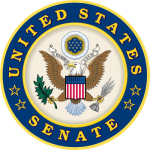- 업종: Government
- Number of terms: 4127
- Number of blossaries: 0
- Company Profile:
The United States Senate is the upper house of the United States Congress. The composition and powers of the Senate are established in Article One of the U.S. Constitution. Each U.S. state is represented by two senators, regardless of population. Senators serve staggered six-year terms.
Term embracing bill, resolution and other matters on which the Senate takes action.
Industry:Government
A vote in which each Senator votes "yea" or "nay" as his or her name is called by the Clerk, so that the names of Senators voting on each side are recorded. Under the Constitution, a roll call vote must be held if demanded by one-fifth of a quorum of Senators present, a minimum of 11.
Industry:Government
Generally, after a committee has amended legislation, the chairman may be authorized by the panel to assemble the changes and what remains unchanged from the original bill and then reintroduce everything as a clean bill. A clean bill may expedite Senate action by avoiding separate floor consideration of each committee amendment.
Industry:Government
A motion to adjourn in the Senate (or a committee) ends that day's session.
Industry:Government
Similar or identical legislation which is introduced in the Senate and House. House and Senate lawmakers who share similar views on legislation may introduce a companion bill in their respective chambers to promote simultaneous consideration of the measure.
Industry:Government
The Parliamentarian is the Senate's advisor on the interpretation of its rules and procedures. Staff from the Parliamentarian's office sit on the Senate dais and advise the Presiding Officer on the conduct of Senate business. The office also refers bills to the appropriate committees on behalf of the Senate's Presiding Officer.
Industry:Government
From the Algonquian Indian language, a caucus meant "to meet together. " An informal organization of Members of the House or the Senate, or both, that exists to discuss issues of mutual concern and possibly to perform legislative research and policy planning for its members. There are regional, political or ideological, ethnic, and economic-based caucuses.
Industry:Government
The principal vehicle employed by lawmakers for introducing their proposals (enacting or repealing laws, for example) in the Senate. Bills are designated S. 1, S. 2, and so on depending on the order in which they are introduced. They address either matters of general interest ("public bills") or narrow interest ("private bills"), such as immigration cases and individual claims against the Federal government.
Industry:Government
A proposed law passed by Congress must be presented to the President, who then has 10 days to approve or disapprove it. The President signs bills he supports, making them law. He vetoes a bill by returning it to the house in which it began, usually with a written message. Normally, bills he neither signs nor vetoes within 10 days become law without his signature.
Industry:Government
Budget authority that becomes available as the result of previously enacted legislation (substantive legislation or prior appropriations act) and does not require current action by Congress. Budget authority is considered to be "current" if provided in the current session of Congress and "permanent" if provided in prior sessions.
Industry:Government
